Oops! 17 SEO Misfires to Avoid With Website Content Marketing
- Fahad H

- Apr 2, 2018
- 8 min read
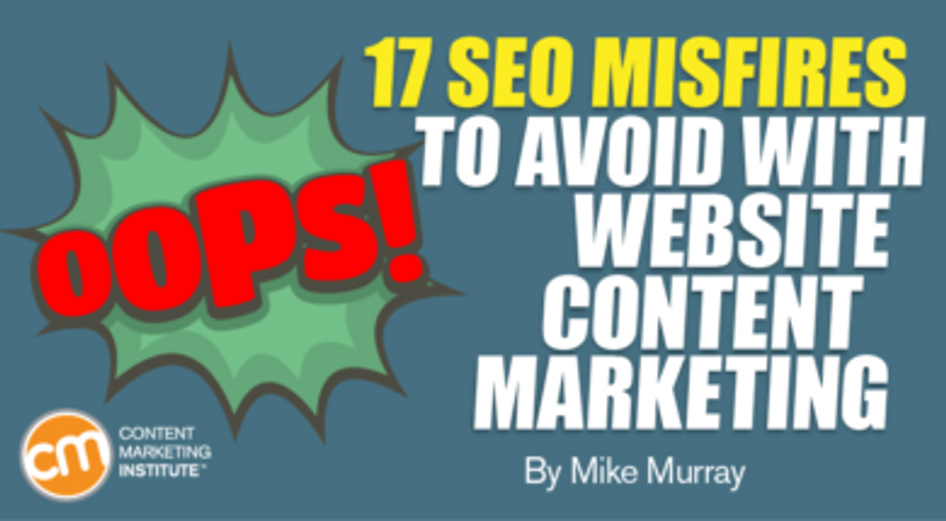
I doubt any marketing team can perfect its SEO and content marketing efforts. Time, degrees of expertise, and changing algorithms always get in the way.
But SEO misfires abound for B2B and B2C websites and they can be avoided or at least minimized.
Let’s dive in.
HANDPICKED RELATED CONTENT: SEO Marketing Strategy: Tips for Success in 2018
1. Keyword selection
Keywords are probably the easiest SEO area to mess up. Aim too high for a competitive keyword phrase and you may never rank. Settle for low-hanging fruit and you might fall asleep while waiting for a rare visitor to make his or her way to your website.Keywords are probably the easiest #SEO area to mess up, says @mikeonlinecoach. Click To Tweet
I tell everyone to focus on relevancy and the sweet spot. What’s a sweet spot with SEO? You can sense it when viewing rankings in Google’s monthly search engine volume.
Try this: Do you tend to rank one to 10 on Google for keywords searched 300 times a month? Maybe 1,000? Get a feel for a variety of your pages. Your sweet spot is the correlation of top 10 rankings and the monthly search volume. Often, your sweet spot is more likely a range, such as 30 to 70, 200 to 500, or 1,200 to 1,500 searches for your one to 10 rankings.
Don’t be dismayed if your site typically ranks well for a keyword phrase that attracts only 50 visits a month. Your products and services may have good price points and margins. In other words, you should be happy with even occasional sales that can more than pay for your SEO investment. And any website page that may rank for multiple keywords can always be working on your behalf.
And the best part? With ongoing SEO, you could pursue more competitive keywords over time. Just don’t go after something with 3,000 searches a month when you can’t even rank for a keyword that has 100 searches each month.
HANDPICKED RELATED CONTENT:
2. Pages attract too many keywords
Your home page often supports tons of keywords because it has the most authority (backlinks). A keyword phrase may rank better if you optimize an interior page.Your site may rank better for a keyword if you optimize an interior page, says @mikeonlinecoach. #SEO Click To Tweet
Take Heinz’s home page, which ranks only ninth for “Heinz Ketchup.”
If Heinz made some changes to its Heinz Tomato Ketchup interior page, it might rank higher for “Heinz Ketchup.”
Heinz made a mistake because its ketchup page URL (http://www.heinz.com/products/heinztomatoketchup) doesn’t have a keyword – it’s jammed with characters and lacks dashes.
A better (with a 301 redirect) page URL would be http://www.heinz.com/products/heinz-ketchup.
The SEO page title needs help too.
Current: Heinz Ketchup Varieties | Heinz Ketchup
Better: Heinz Ketchup
The page’s visible content could remain until the title and URL changes affect search engine rankings and updated a little after that.
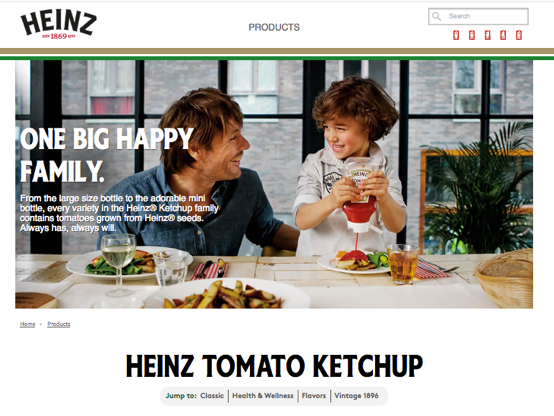
HANDPICKED RELATED CONTENT: 5 SEO Strategies for Social Media You Need to Know Before You Hit Publish
3. Engagement
Search engines like Google want users to have a good experience. If people jump from your website right away and conduct another search, it could affect your rankings. Time spent on a page matters with SEO and content marketing.Time spent on a page matters with #SEO and #contentmarketing, says @mikeonlinecoach. Read more>> Click To Tweet
Generally, you want people to visit and make their way to other content pages. Unfortunately, those pages may not be well designed, may lack compelling content, or may switch visitors to a different language.
Yes, it happens.
Ernst & Young takes visitors from English pages to the Netherlands (I wonder how often pages are reviewed by the marketing team).
My trip began on what must be a popular page about risk assurance. I hovered over “cybersecurity” in the menu (as shown in the URL on the lower left of the screenshot):
And, in a second, I flew across the pond.
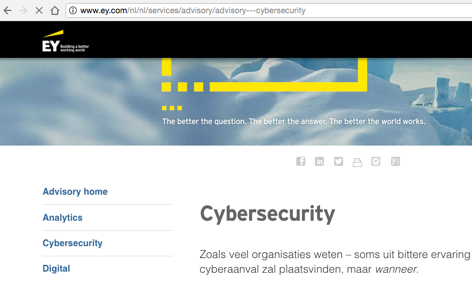
The conflicting language issue exists in part because thousands of Ernst & Young pages are indexed. I came across its English global version, which is indicated by the GL in the URL that I saw when checking the company’s ranking data. But it’s still odd that the language would change to the Netherlands – for cybersecurity and all other sections linked from the risk assurance and other pages within the global content.
HANDPICKED RELATED CONTENT: 5 Reasons SEO Should Take a Back Seat With Website Content
4. Content headers
It’s best to use an H1 header tag with page content headers to identify important text. Unfortunately, headers often lack strategic keyword phrases.Use H1 tags to identify the content’s strategic keyword phrases, says @mikeonlinecoach. #SEO Click To Tweet
Citi has this page: http://www.citigroup.com/citi/about/citizenship/.
The H1 is “global citizenship.” No one can do much with that in search.
Or Cognizant has “business value of trust” as its H1 on this page: https://www.cognizant.com/business-value-of-trust.
But Nationwide does it better. It consistently leverages H1 tags like “choosing a cheap car insurance company” for: https://www.nationwide.com/cheap-car-insurance-companies.jsp. (I’m a fan of its SEO efforts.)
HANDPICKED RELATED CONTENT: Must-Have Checklist to Creating Valuable Content
5. SEO page titles
It’s important for SEO page titles to include relevant keyword phrases. But sometimes the words used by content marketers in the titles aren’t well represented in the content.It’s important for #SEO page titles to include relevant keyword phrases, says @mikeonlinecoach. Click To Tweet
Brands frequently mention their names in SEO page titles. Unfortunately, their inclusion limits the prominence of the remaining keywords. And sometimes the same words are repeated.
Here is an example from Cognizant, which uses “solutions” twice: “Healthcare BPO, IT Solutions and Services | Cognizant Technology Solutions.”
Keyword redundancy isn’t the only issue. The page’s content never mentions BPO or business process outsourcing. It’s probably not going to rank for “IT solutions,” which is too broad for this page, but it may be a good companion to “healthcare.”
A better SEO page title may be: “Healthcare BPO and IT Solutions.”
If Cognizant makes the change, the company may rank higher for “healthcare BPO.”
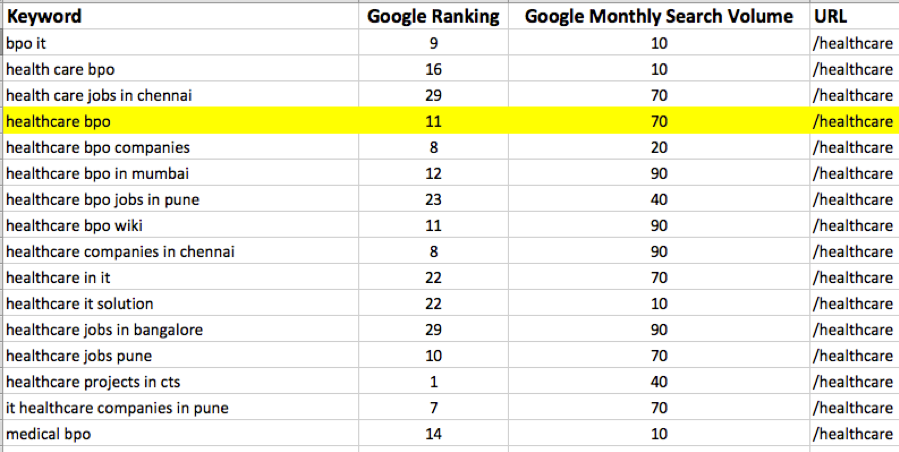
HANDPICKED RELATED CONTENT: SEO Page Titles: 15-Point Checklist for B2B and B2C Brands
6. Image names
With SEO best practices – and knowing people search many ways – why wouldn’t you name images after keywords (use dashes to separate words)? Cognizant misses the mark with its image names like: “education-banner_436485.jpg.” A name like “education-consultant-colleges-universities.jpg” may be an improvement:
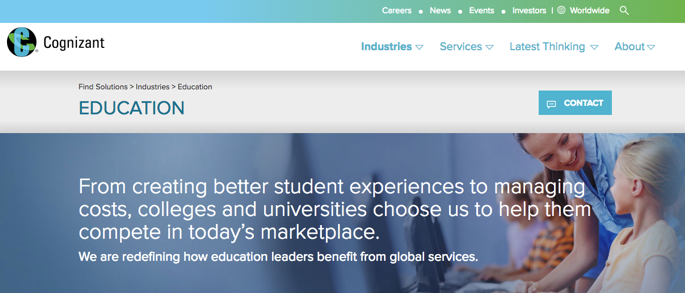
HANDPICKED RELATED CONTENT: SEO and Website Image Optimization 10-Point Checklist for Marketers
7. Image alternative (alt) text
Too often marketers ignore the alt text and don’t include a short description for search engines. Make sure the code doesn’t show an empty alt=“” attribute.
8. Internal links
Search engines consider your internal links and not just the ones in your primary navigation. Look for ways to use links to connect your relevant pages. If you have paragraph after paragraph, why wouldn’t you include an internal link in the text to guide a visitor to your other content?Look for ways to use links to connect your relevant pages, says @mikeonlinecoach. #SEO Click To Tweet
Don’t make the mistake like Archer Daniels Midland Company (ADM) does. It often has extended content without a single link to another page – like this description of container services:
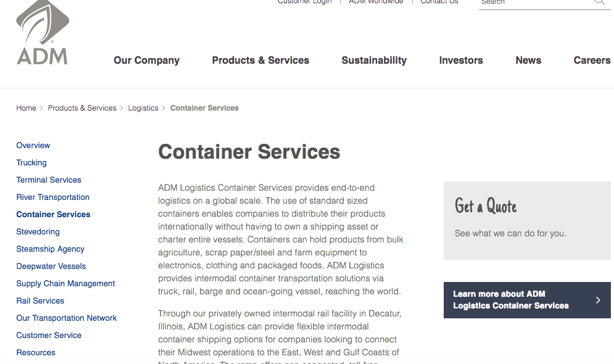
9. Calls to action
It would be silly to put in motion SEO tactics for higher rankings and traffic if the content fails on the call-to-action front. But it happens all the time. SEO should be part of a holistic content marketing strategy.
ADM falls short left and right with calls to action. I found numerous pages that tease visitors with “Get a quote: See what we can do for you.” But the words don’t link to anything.
In this example, it includes the word “contacts” in the right side, but whom to contact is a mystery.
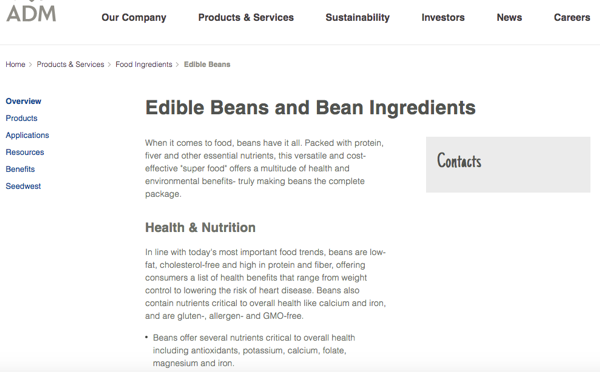
At least ADM includes a phone number on some pages. But too many companies do not. Why wait until the bottom of content to mention the phone number? Find a way to feature it higher in the text, a separate box, etc. Even in this case, the phone number could have been emphasized better by bolding it or using a different color – or doing both.

10. Broken links
Track broken links on your website. They can be created because of typos or content deleted without a 301 redirect. In a small way, broken links can make a poor impression on search engines and prompt users to go elsewhere.
11. Custom 404 pages
Given that broken links are inevitable, you should have a custom 404 page that guides visitors to relevant content and popular pages you don’t want them to miss.Broken links are inevitable. Customize them to guide visitors to popular pages, says @mikeonlinecoach. #SEO Click To Tweet
Siemens doesn’t exactly go out if its way to help anyone.
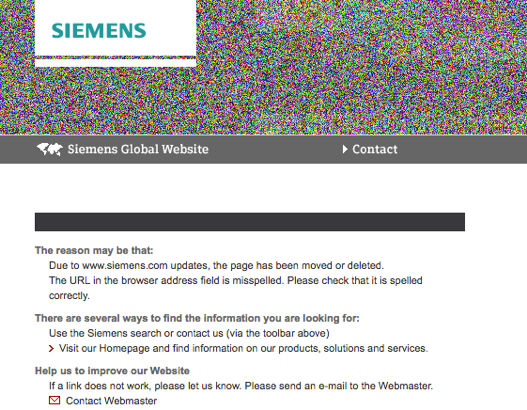
Lego does a better job, but I still think the company could highlight more content on this eye-catching error page:
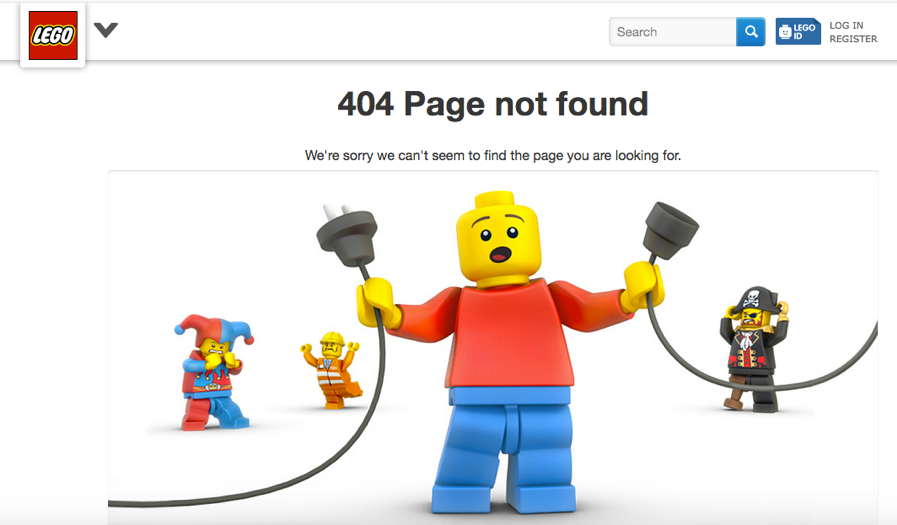
12. Unsolicited backlinks
Everyone wants to get backlinks from other websites to help achieve higher search engine rankings (search engines reward quality links from other websites).
But watch out for questionable links that just come your way even if you don’t seek them. Moz and SEMrush have tools to help you find the lousy ones. Use the disavow option in Google Search Console to report them so they won’t hurt your backlink profile.Use tools like @moz & @semrush to help find unsolicited backlinks, says @mikeonlinecoach. #SEO Click To Tweet
Here is what SEMrush shows for a Target backlink from submiturls.net:
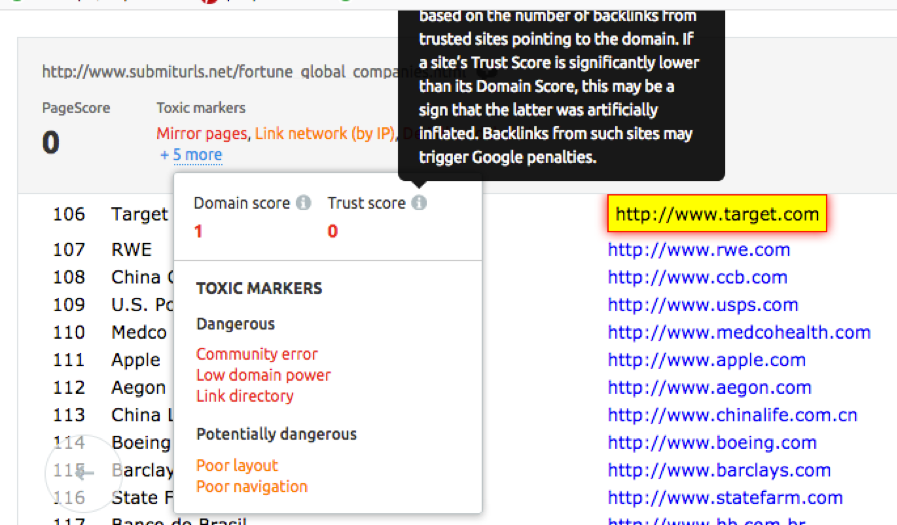
Check out this collection of indicators for backlinks SEMrush calls toxic.
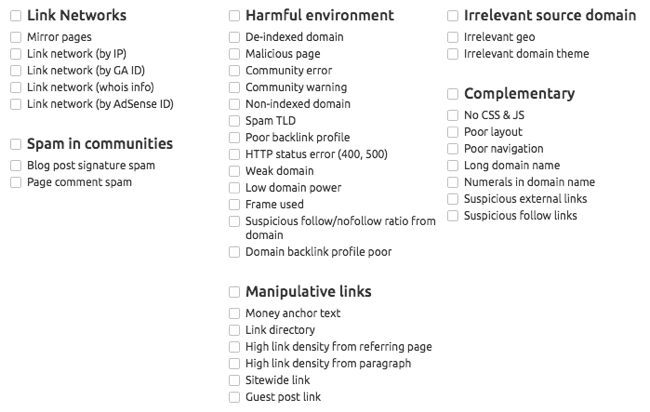
13. URLs
I encourage companies to use keyword phrases in their page URLs. But keep them short – maybe three to five words. Anything longer looks spammy and could detract from the keywords you’re targeting.
Keep in mind that large websites can often overlook SEO best practices and rank well anyway. Backlinks, website age, etc., help them overcome any defects. For example, Lowes ranks No. 2 for “gas grills” on Google even though “grills” is used three times in a row.
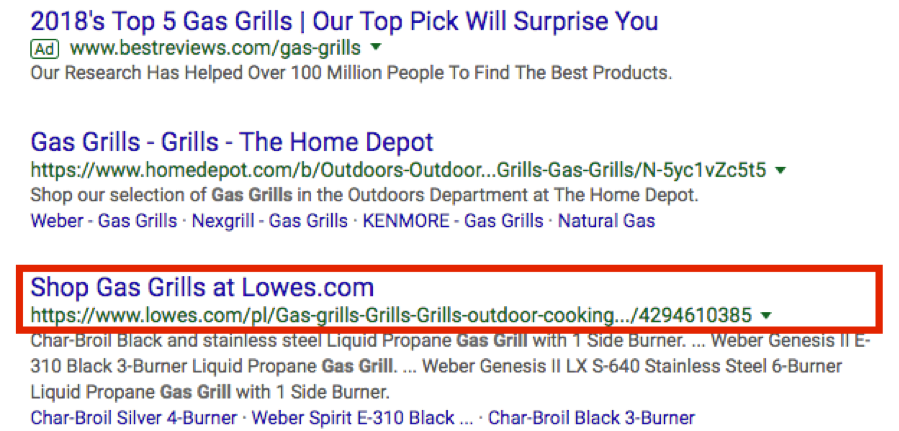
14. Domain names
It still helps to have a keyword in the domain name, but you need to leverage other tactics and opportunities to make the most of it.
ShipHawk (shiphawk.com) does well for “shipment tracking software” – No. 2 on Google. And it’s No. 4 for “shipping a painting.”
But it should work harder to align URLs with SEO page titles, content headers, and the overall content.
Let’s explore one of its pages.
Original URL: https://shiphawk.com/shipping-intelligence.
It looks good at first glance. But “intelligence” isn’t anywhere in the content.
The content header is excellent – “Real Time Shipping Data & Analytics.”
Original SEO page title: Real Time Shipping Data and Analytics | ShipHawk
I like the SEO page title (but I would tweak it).
Shipping keywords may rank higher if ShipHawk changes its SEO title and page URL while keeping “shipping,” which is reinforced by the domain name.
Better URL: https://shiphawk.com/real-time-shipping-analytics
Better SEO page title: Real Time Shipping Data and Analytics
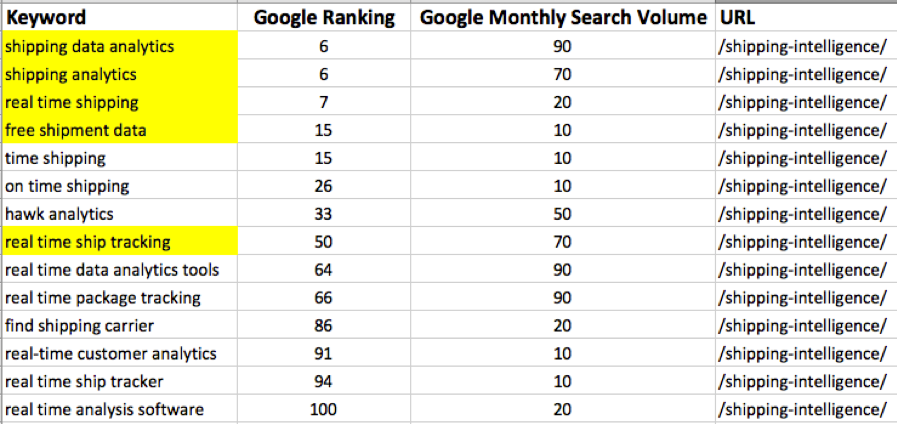
15.Server redirects (www and non-www)
Over the years, I’ve seen many websites appear to have duplicate content even though they have only one set of content pages. Often, one URL includes “www” and another URL does not but they both go to the same page.
For example, I might start with www.misfiresdomainexample.com. But I shouldn’t go to misfiresdomainexample.com and see the same pages without the www. Search engines could reasonably think someone is trying to game them – creating two websites to get extra rankings.
16. HTTPS vs. HTTP
If you haven’t done it, you should consider moving your website to HTTPS from HTTP. Google has been pushing the more secured connection. It’s possible your site might get a slight edge with rankings. But even if you don’t, appearances are everything. For example, Google Chrome calls out websites as not secure when they lack the basic security feature known as SSL (Secure Sockets Layer).Move your website from http to https for a possible #SEO boost, says @mikeonlinecoach. Click To Tweet
I was surprised to see that Ernst & Young hasn’t switched to HTTPS:
Bissell attempted to use HTTPS, but it still gets the dreaded security alert on Google because some page elements aren’t secure.
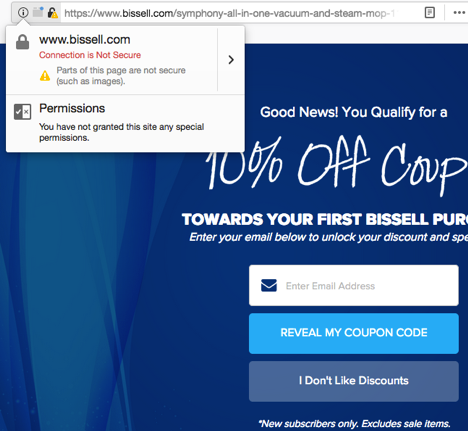
17. Failure to make new content – for SEO
Don’t settle for the normal content planning routines or keep fighting SEO battles on old pages.
After you’ve updated your website for SEO, it’s sometimes best to just expand it. Invent new pages where you can get everything right from the start. Write some content on the longer side – maybe 1,000 words. Get the right URL, SEO page title, H1 header, etc. Send it some love with internal links from popular pages on your website.
Conclusion
Always take advantage of the possibilities right in front of you if you want to make leaps with your search engine visibility.
What’s been your experience? What SEO misfires have you encountered and corrected?
Please note: All tools included in our blog posts are suggested by authors, not the CMI editorial team. No one post can provide all relevant tools in the space. Feel free to include additional tools in the comments (from your company or ones that you have used).
Don’t make a misfire in your content marketing training. Plan today to attend Content Marketing World Sept. 4-7. Register today using code BLOG100 to save $100.
Cover image by Joseph Kalinowski/Content Marketing Institute








Comments